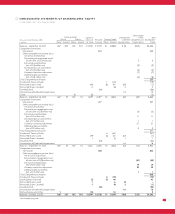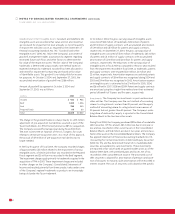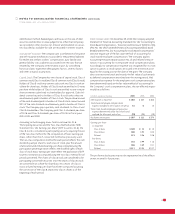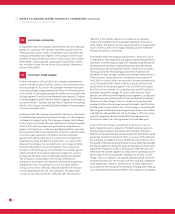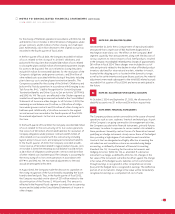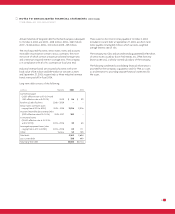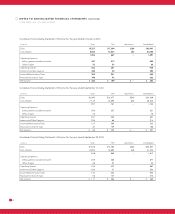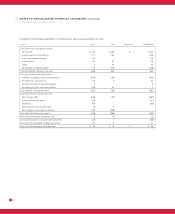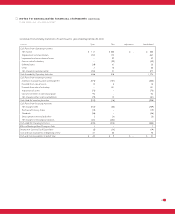Tyson Foods 2004 Annual Report Download - page 41
Download and view the complete annual report
Please find page 41 of the 2004 Tyson Foods annual report below. You can navigate through the pages in the report by either clicking on the pages listed below, or by using the keyword search tool below to find specific information within the annual report.
39
NOTES TO CONSOLIDATED FINANCIAL STATEMENTS (CONTINUED)
for the closing of the Berlin operation in accordance with SFAS No. 146
and SFAS No. 144. At October 2, 2004, $9 million of obligations under
grower contracts and $3 million of other closing costs had been
paid. Additionally, a $2 million decrease to the original accrual was
recorded in the fourth quarter of fiscal 2004.
In the first quarter of fiscal 2003, the Company recorded $47 million
of costs related to the closing of its Stilwell, Oklahoma, and
Jacksonville, Florida, plants that included $26 million of costs related
to closing the plants and $21 million of estimated impairment charges
for assets to be disposed. The costs related to closing the plants
include $17 million for estimated liabilities for the resolution of the
Company’s obligations under grower contracts, and $9 million of
other related costs associated with the closing of the plants including
plant clean-up costs and employee termination benefits. The
Company accounted for the closing of the Stilwell, Oklahoma, and
Jacksonville, Florida, operations in accordance with Emerging Issues
Task Force No. 94-3, “Liability Recognition for Certain Employee
Termination Benefits and Other Costs to Exit an Activity” (EITF 94-3)
and SFAS No. 144. The costs are reflected in the Chicken segment as
a reduction of operating income and included in the Consolidated
Statements of Income in other charges. As of October 2, 2004, the
remaining accrual balance was $1 million, as $16 million of obliga-
tions under grower contracts and $13 million of other closing costs
had been paid. Additionally, a $4 million increase to the original
accrual amount was recorded in the fourth quarter of fiscal 2004.
No material adjustments to the total accrual are anticipated at
this time.
In the fourth quarter of fiscal 2002, the Company recorded $26 million
of costs related to the restructuring of its live swine operations
that consists of $21 million of estimated liabilities for resolution of
Company obligations under producer contracts and $5 million of
other related costs associated with this restructuring, including
lagoon and pit closure costs and employee termination benefits.
In the fourth quarter of 2004, the Company recorded an addi-
tional reserve of $6 million related to lagoon and pit closures costs.
At October 2, 2004, the remaining accrual balance was $18 million,
as $6 million of obligations under grower contracts and $8 million
of other related costs had been paid. The Company is accounting for
the restructuring of its live swine operations in accordance with
EITF 94-3 and SFAS No. 144. No material adjustments to the total
accrual are anticipated at this time.
In August 2002, the Company made the decision to capitalize on
the strong recognition of the Tyson brand by expanding the Tyson
brand to beef and pork. Thus, in the fourth quarter of fiscal 2002,
the Company recorded a write-down of $27 million related to the
discontinuation of the Thomas E. Wilson brand. This amount is
reflected in the Prepared Foods segment as a reduction to operating
income and included on the Consolidated Statements of Income in
other charges.
NOTE FIVE : BSE-RELATED CHARGES
On December 23, 2003, the U.S. Department of Agriculture (USDA)
announced that a single case of BSE had been diagnosed in a
Washington State dairy cow. The effect on the Company’s Beef
segment caused by that announcement, along with the decision of
various countries to restrict imports of U.S. beef products, resulted
in the Company recording BSE-related pretax charges of approximately
$61 million in fiscal 2004. These charges were included in cost of
sales and primarily related to the decline in value of finished product
inventory destined for international markets, whether in-transit,
located at the shipping ports or located within domestic storage,
as well as live cattle inventory and open futures positions. No material
adjustments were made subsequent to the initial BSE-related accruals
recorded in first quarter of fiscal 2004, and none are anticipated in
the future.
NOTE SIX : ALLOWANCE FOR DOUBTFUL ACCOUNTS
At October 2, 2004, and September 27, 2003, the allowance for
doubtful accounts was $11 million and $16 million, respectively.
NOTE SEVEN : FINANCIAL INSTRUMENTS
The Company purchases certain commodities in the course of normal
operations such as corn, soybeans, livestock and natural gas. As part
of the Company’s on-going commodity risk management activities,
the Company uses derivative financial instruments, primarily futures
and swaps, to reduce its exposure to various market risks related to
these purchases. Generally, contract terms of a financial instrument
qualifying as a hedge instrument closely mirror those of the hedged
item, providing a high degree of risk reduction and correlation.
Contracts that are designated and highly effective at meeting the
risk reduction and correlation criteria are recorded using hedge
accounting, as defined by Statement of Financial Accounting
Standards No. 133, “Accounting for Derivative Instruments and
Hedging Activities” (SFAS No. 133), as amended. If a derivative
instrument is a hedge, as defined by SFAS No. 133, changes in the
fair value of the instrument will either be offset against the change
in fair value of the hedged assets, liabilities or firm commitments
through earnings or recognized in other comprehensive income
(loss) until the hedged item is recognized in earnings. The ineffective
portion of an instrument’s change in fair value will be immediately
recognized in earnings as a component of cost of sales.




